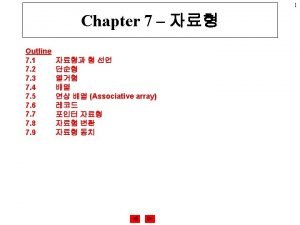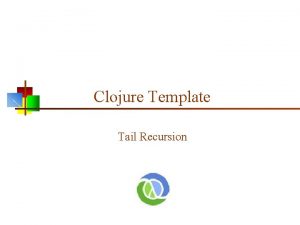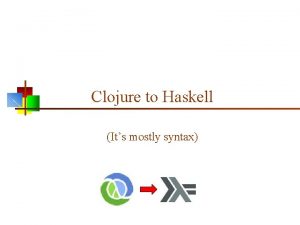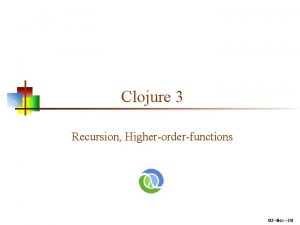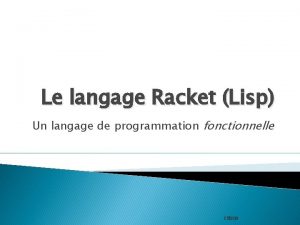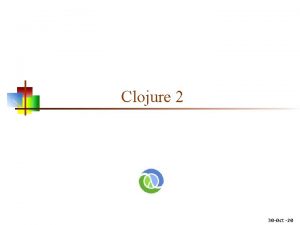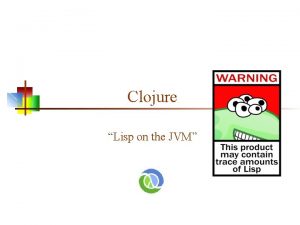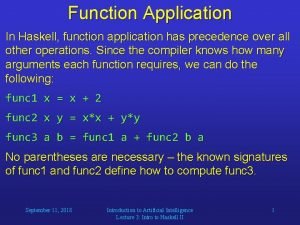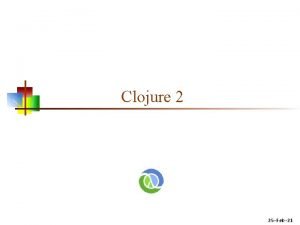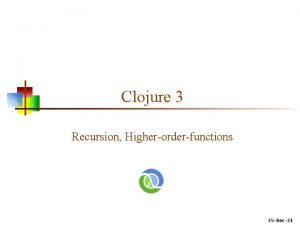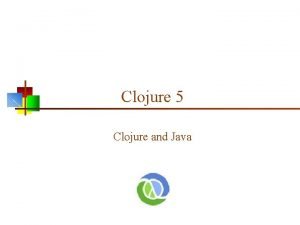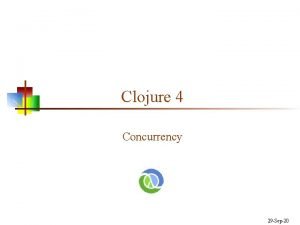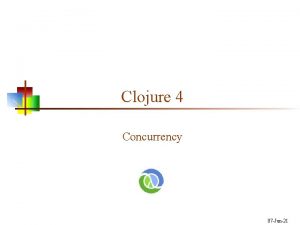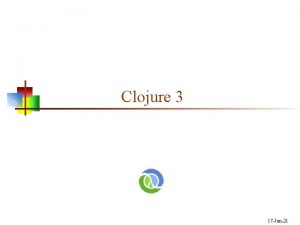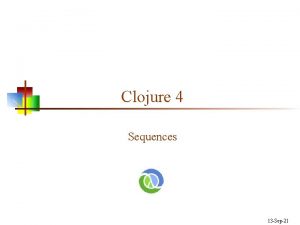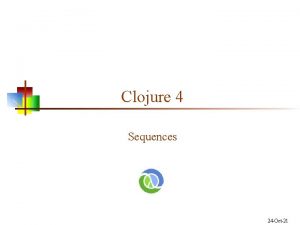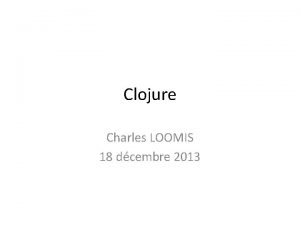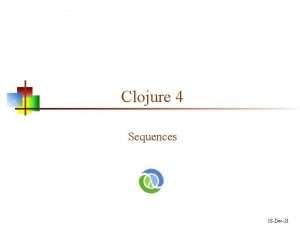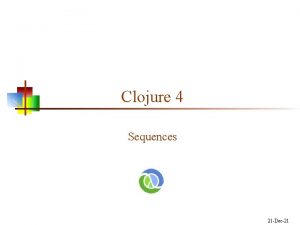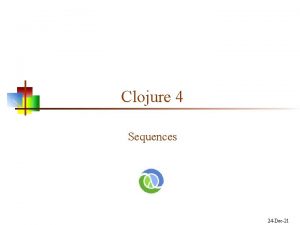Clojure 2 30 Oct20 Running Clojure n C



![Functions n The syntax to define a named function is: (defn function_name [arguments] expressions) Functions n The syntax to define a named function is: (defn function_name [arguments] expressions)](https://slidetodoc.com/presentation_image/297dc335cde622f9a9e2caa7cad903da/image-4.jpg)






![Anonymous functions n n An anonymous function has the syntax: (fn [parameters] body) Example: Anonymous functions n n An anonymous function has the syntax: (fn [parameters] body) Example:](https://slidetodoc.com/presentation_image/297dc335cde622f9a9e2caa7cad903da/image-11.jpg)



- Slides: 14

Clojure 2 30 -Oct-20


Running Clojure n C: UsersDave>cd C: Programsclojure-1. 2. 0>java -cp clojure. jar clojure. main Clojure 1. 2. 0 user=> (load-file "E: /Programming/Clojure programs on E/test. clj") #'user/fruit user=> n n Although j. Edit has a clojure mode, I don’t like it n n n The response, #'user/fruit, is because “fruit” was the last thing defined on this file Syntax coloring is good, but indentation is strange (buggy? ) and agressive The lisp mode doesn’t syntax color as well, but indents properly Comments: n n A “doc” string is a string that goes just before the parameter list Other comments start with a semicolon (; ) and extend to the end of the line
![Functions n The syntax to define a named function is defn functionname arguments expressions Functions n The syntax to define a named function is: (defn function_name [arguments] expressions)](https://slidetodoc.com/presentation_image/297dc335cde622f9a9e2caa7cad903da/image-4.jpg)
Functions n The syntax to define a named function is: (defn function_name [arguments] expressions) n n The value of the function is the value of the last expression evaluated The syntax of a function call is (function arguments) n n Notice that the function being called is the first thing inside the parentheses This need not be the name of a function; it can be any expression that results in a function 4

Tail recursion (Erlang) n n Non-tail recursive function to find the length of a list: len([]) -> 0; len([_ | T]) -> 1 + len(T). Tail recursive function to find the length of a list: len(L) -> len(0, L). len(N, []) -> N; len(N, [_ | T]) -> len(N + 1, T).

Tail recursion (Clojure) n n Non-tail recursive function to find the length of a list: (defn len-1 [lst] (if (empty? lst) 0 (inc (len-1 (rest lst))) ) ) Tail recursive function to find the length of a list: (defn len-2 ([lst] (len-2 0 lst)) ([n lst] (if (empty? lst) n (len-2 (inc n) (rest lst))) ) )

recur n n n The previous function, len-2, is tail-recursive, but the compiler doesn’t optimize it into a loop Clojure runs on the JVM, which doesn’t optimize tail recursion Workaround: (defn len-2 ([lst] (len-2 0 lst)) ([n lst] (if (empty? lst) n (recur (inc n) (rest lst))) ) )

Tail recursion (Erlang) n Non-tail recursive function to find the factorial: factorial(1) -> 1; factorial(N) -> N * factorial(N - 1). n Tail recursive function to find the factorial: factorial(N) -> factorial(1, N). factorial(Acc, 1) -> Acc; factorial(Acc, N) -> factorial(N * Acc, N - 1).

Tail recursion (Clojure) n Non-tail recursive function to find the factorial: n Tail recursive function to find the factorial: (defn factorial-1 [n] (if (= n 1) 1 (* n (factorial-1 (dec n))) ) (defn factorial-2 ([n] (factorial-2 1 n)) ([acc n] (if (= n 1) acc (recur (* n acc) (dec n)) )

map n n (def fruit '((apple red) (banana yellow) (cherry red))) user=> (map first fruit) (apple banana cherry) (defn my-map [f lst] (if (empty? lst) () (cons (f (first lst)) (my-map f (rest lst))) ) ) user=> (map my-first fruit) (apple banana cherry)
![Anonymous functions n n An anonymous function has the syntax fn parameters body Example Anonymous functions n n An anonymous function has the syntax: (fn [parameters] body) Example:](https://slidetodoc.com/presentation_image/297dc335cde622f9a9e2caa7cad903da/image-11.jpg)
Anonymous functions n n An anonymous function has the syntax: (fn [parameters] body) Example: (fn [x] (* x x))

filter n n (def fruit '((apple red) (banana yellow) (cherry red))) user=> (filter (fn [x] (= (second x) 'red)) fruit) ((apple red) (cherry red)) (defn my-filter [p lst] (cond (empty? lst) () (p (first lst)) (cons (first lst) (my-filter p (rest lst))) : else (my-filter p (rest lst)) ) ) user=> (my-filter (fn [x] (= (second x) 'red)) fruit) ((apple red) (cherry red))

Speaking of maps… n A map or hash is a sequence of key/value pairs, enclosed in braces, for example, {: ace 1, : deuce 2, "trey" 3} n n n A map is also a function: n n n Elements are separated by whitespace or commas It is helpful to use commas between key/value pairs user=> (def cards {: ace 1, : deuce 2, "trey" 3}) #'user/cards user=> (cards : deuce) 2 Keywords are also functions: n user=> (: deuce 2 cards)

The End
 Running running running
Running running running Once upon a time there lived a little country girl
Once upon a time there lived a little country girl Clojure
Clojure Clojure factorial
Clojure factorial Clojure haskell
Clojure haskell Tail recursion in java
Tail recursion in java Penox mexico
Penox mexico Clojure app engine
Clojure app engine Clojure language
Clojure language Clojure factorial
Clojure factorial Lisp vs clojure
Lisp vs clojure Haskell guards
Haskell guards A bank wishes to survey its customers
A bank wishes to survey its customers Fitt for running
Fitt for running In running nip points
In running nip points


